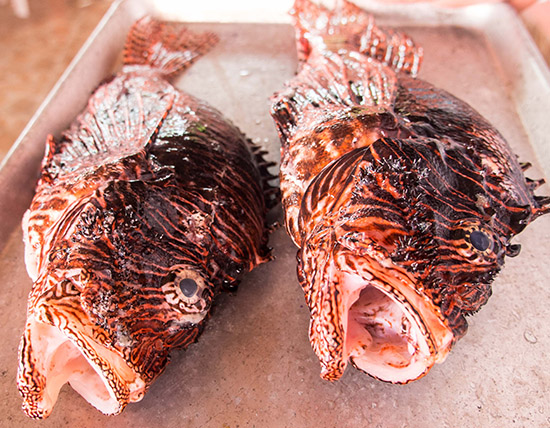The Market Tames a Lion
 Lionfish ready for the pan at Cozumel Fishermen's Coop © John Reid
Lionfish ready for the pan at Cozumel Fishermen's Coop © John Reid
In 1992 Hurricane Andrew liberated a tankful of lionfish from a Florida aquarium. More may have been dumped in the sea before then and after, but the event stuck in the collective imagination as the start of a biological invasion.
The ornate fish wasted little time in multiplying and fanning out across the Caribbean and the Atlantic Coast of the US. Divers and biologists feared the worst. The voracious lionfish threatened to erase competitors from reefs throughout the region. The Asia-Pacific native lacks local predators, breeds year-round and isn’t particularly prone to disease in this part of the world. NOAA describes their spread in the Caribbean and Atlantic “one of the most rapid invasions in history.”
Cozumel was no exception. During a trip this week with the German technical cooperation agency, GiZ, and Mexico's national park service, I learned that lionfish arrived here in 2009, threatening the Mexican island’s huge dive tourism business. The first message officials gave was that the fish are venomous. Indeed they do have poisonous spines at the extremes of their fins. People avoided them. The fish prospered.
But quickly the managers of the Cozumel Reefs National Park, overseen by the National Commission for Natural Protected Areas (CONANP), recognized the obvious solution to the invasion: Eat the fish. First they had to convince diners that lionfish are only toxic on the outside. After a creative PR campaign, and evidence that people were just fine after eating them, lionfish caught on.
At the open-air restaurant in the Cozumel Fishing Cooperative this week, I ate lionfish ceviche, deep-fried lionfish cheeks and lionfish fillets simmered in garlic sauce. All excellent. The cooperative exports about 800 kilos from the island every month, which translates into around 18,000 fish a year. And that doesn’t count all the fish gobbled by locals and tourists on the island.
The national park’s invasive species program has tallied around 15-20 lionfish per hectare (2.5 acres) on the reefs, compared to hundreds in highly infested sites where they’re not actively pursued. Park staffers have no illusions about exterminating the species from Cozumel but are satisfied to have them controlled to something like their natural abundance in the South Pacific and Indian Ocean.
Too often market solutions to environmental problems are built on the shaky foundation of wishful thinking – a hope that a market will emerge for important but intangible things like biodiversity. This one is built on a real market. Market solutions work well when the good in question can’t be had for free (e.g., clean air) and when it’s similar to other goods people already buy (e.g., other fish).
The market has worked so well in Cozumel that, five years after its arrival, lionfish demand now outstrips supply, particularly impressive because the fish, which fishermen spear one-by-one, aren’t cheap. It’s a long shot, but the thriving Cozumel lionfish market raises the tantalizing possibility of eating invasive species to the point of collapse, the way we’ve unintentionally done to so many native fish.
- Log in to post comments
